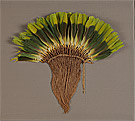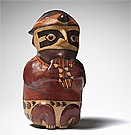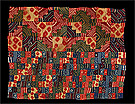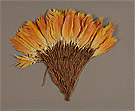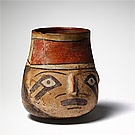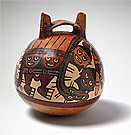Exhibition themes Nazca
The Nazca culture was situated in the Río Grande de Nazca and Ica valleys of the south coast. It had strong links with its Paracas predecessors. In 1901 graves in shaft-like tombs were discovered at the Ocucaje excavations. They contained the seated bodies of ordinary people surrounded by polychrome ceramic vessels. Nazca imagery included deities that incorporated attributes of humans and local animals, birds and sea creatures. Trophy heads were an important subject and, over time, designs became increasingly abstract.
Bold lines and colourful patterns are typical of much Nazca art, notably the outlining of forms on ceramics and textiles. Most famous are the extensive Nazca lines on the desert plains, created by removing red stones so that lighter soil shows through. Due to the climate's extreme dryness, these huge geometric and zoomorphic geoglyphs have remained visible and undisturbed for centuries.
Irrigation was made possible by the construction of underground channels to bring water to crops and animals, aqueducts which are still used today. Catastrophic floods from El Niño led to the downfall of the Nazca culture, as overflowing water could not be absorbed into the deforested valleys.




